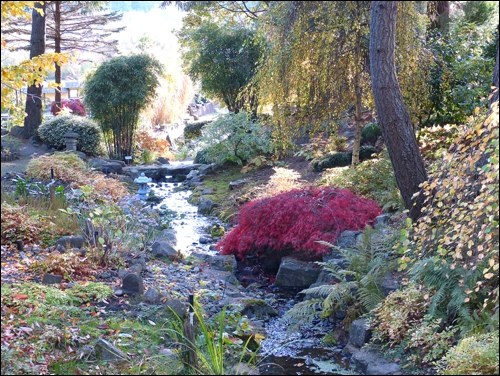Next time you’re in Victoria, you should take the time to visit two of Victoria’s lesser-known gardens. Where one is sheltered, quiet and secluded, the other is larger, more diverse, and teeming with dozens of projects.
For tranquility nothing can compare to the quiet beauty of Finnerty Garden (www.uvic.ca/finnerty/), located in the southwest corner of the University of Victoria campus just beyond the small Interfaith Chapel. Wandering along the network of shaded paths, sitting on one of the many carefully placed benches enjoying trees reflected in a pond or simply absorbing the interplay of colour and texture, peace prevails throughout. One would never realize they were in the middle of a busy campus and adjacent to a parking lot.
The garden is named after the two Finnerty brothers who emigrated from Ireland in the 1850s. They established a market garden and orchard on the land now occupied by the garden. Their families continued to farm the land until about 1926.
Finnerty Gardens was established in 1975 with the planting of a notable collection of Rhodendron species, many obtained directly or indirectly from famous plant explorers of the day. The collection – the largest such in British Columbia – was a part of the estate that Jeanne Buchanan of Cowichan Lake left the university. Many of the specimens were more than 50 years old when they were transplanted to their new home.
Today, the Finnerty Gardens contains more than 4,000 trees and shrubs, among them magnolia, maple, birch, spruce, Douglas fir and the native Garry oak. There are more than 1,500 rhododendron (flowering from mid-January to June) and azaleas as well as an enormous range of herbaceous under-plantings and naturalized bulbs such as tulips, narcissi, anemone, bluebells, grape hyacinth, pink nerine, camas, fritillary, marsh marigolds, bleeding heart, oxalis, ornamental grasses and many ferns.
For your horticultural pleasure and enlightenment, most plants are labeled (with common and botanical names). A detailed plan and walking tour of the 6.5 acre site is available for download from the garden website. Finnerty Gardens is open to the public during daylight hours at no charge.
The Horticulture Centre of the Pacific (www.hcp.ca) is the only private not-for-profit post-secondary institution in British Columbia accredited by the province to provide horticulture education. With 103 acres of gardens, woodlands and wetlands, it is located on the southern tip of Vancouver Island in Saanich, just 15 minutes from downtown Victoria.
What impressed me the most at the HCP in late October? The sweep of meadow below the demonstration gardens with its curving border of tall billowing ornamental grasses and centerpiece sculpture figuratively (and almost literary) blew me away. And situated on the crest of the hill above the Japanese Garden, in an irregular oval space surrounded by venerable trees, were four waist-height half-moon-shaped tables used to display an amazing collection of bonsai.
The gardens within HCP are many and varied: collections of heather, rhododendron, lilies and hardy plants; the Doris Page Winter Garden and the Takata Japanese Garden complete with a ceremonial teahouse; drought tolerant and Mediterranean gardens; a native plant garden; a children’s garden along with a birds, bees and butterflies garden; vegetable, fruit, herb gardens and orchard; and the largest bonsai collection in Canada.
They are cared for by volunteers, affiliate gardening societies, centre staff and students. Private tours, group tours and school tours are available. The gardens are seen as a “living classroom” and well used throughout the year by students, the on-site Master Gardener program and individuals attending the numerous workshops and specialty lectures. There is a restaurant and small gift shop on site.
Sara Williams is the author of the newly expanded and revised Creating the Prairie Xeriscape; Gardening, Naturally: A chemical-free handbook for the Prairies; and the Saskatoon Forestry Farm Park & Zoo: A Photographic History. Sara will be offering tours of England and Iceland (with cohost, Melanie Elliott) in 2016. For more information contact Ruth at ruth@worldwideecotours.com or 888-778-2378.



